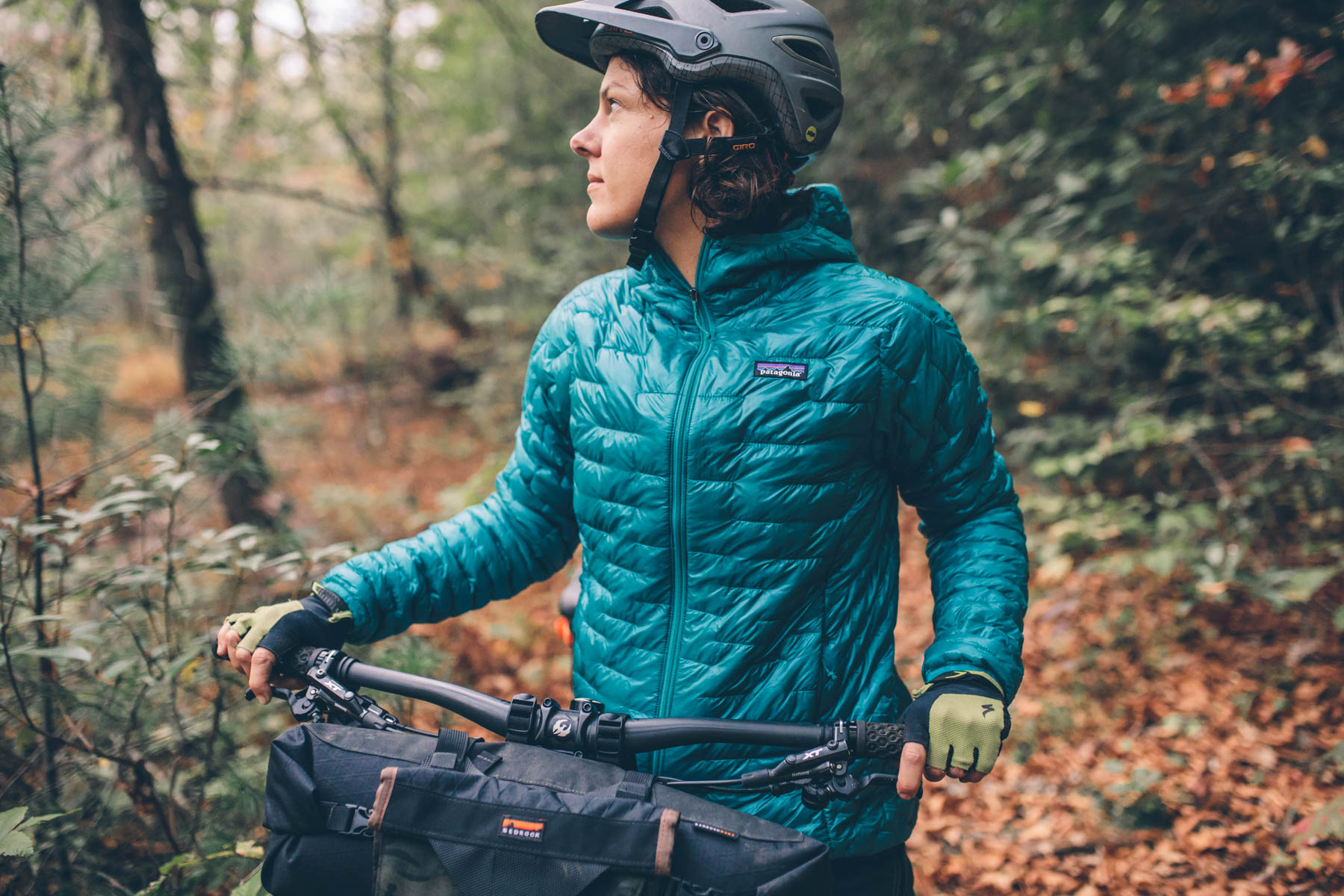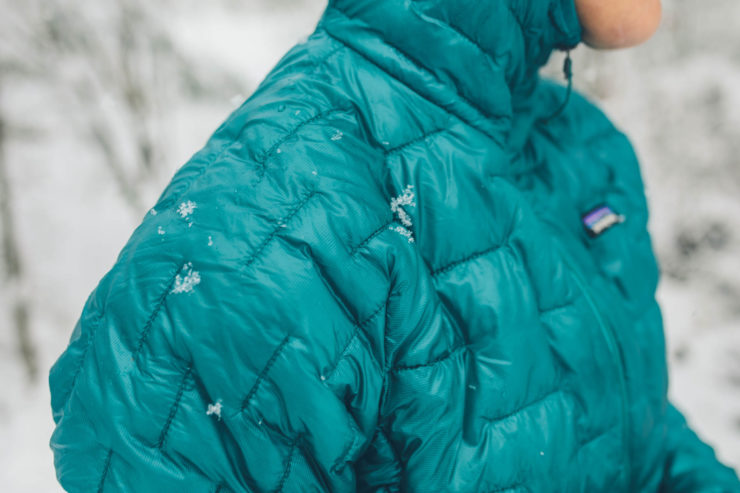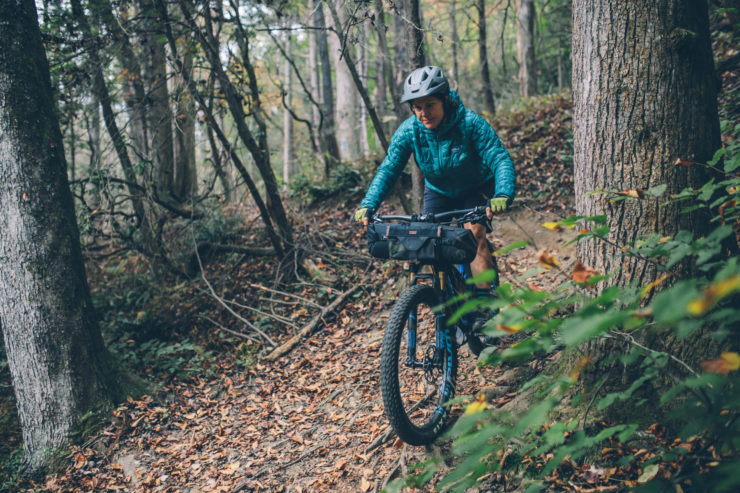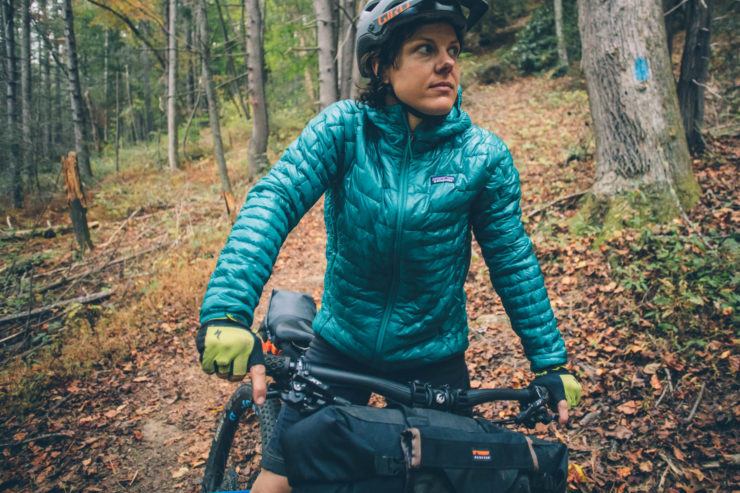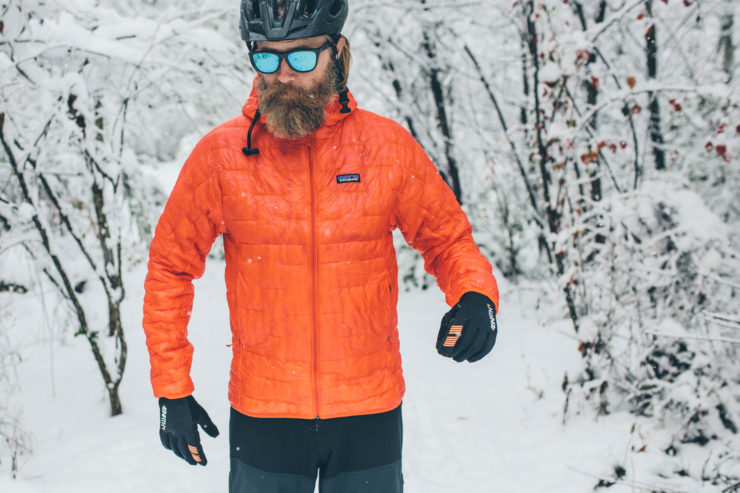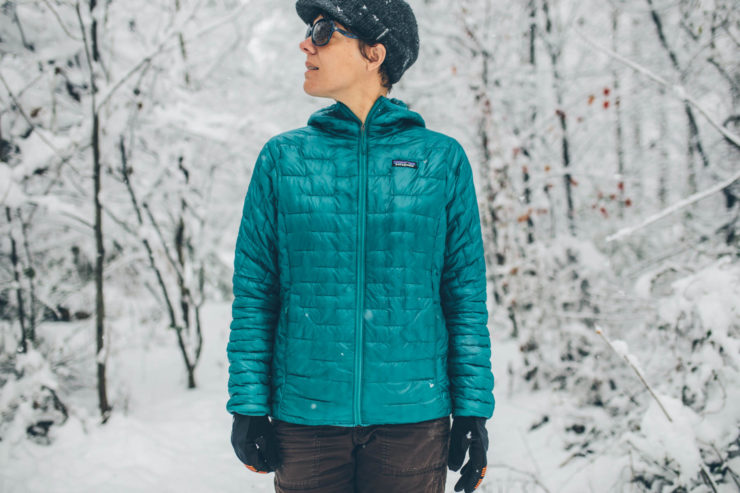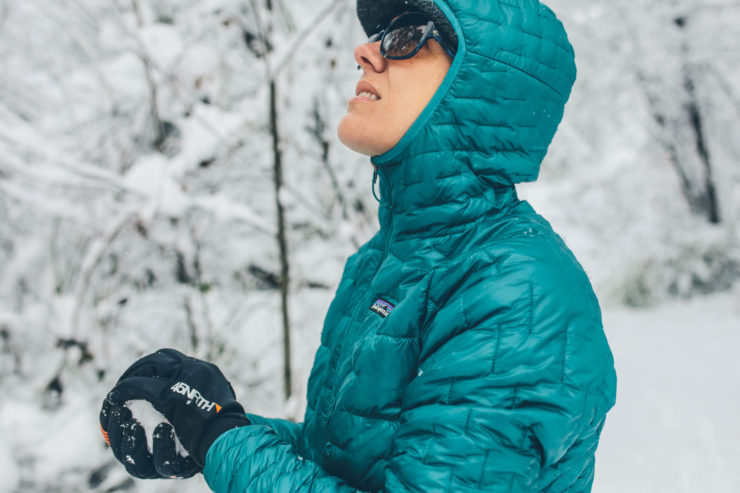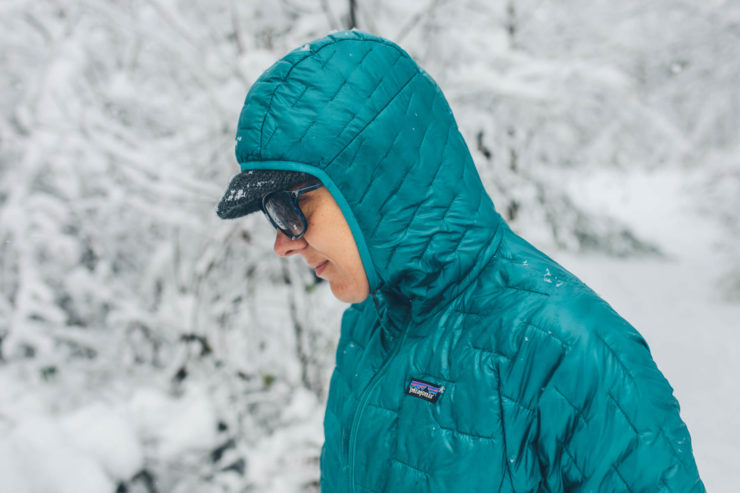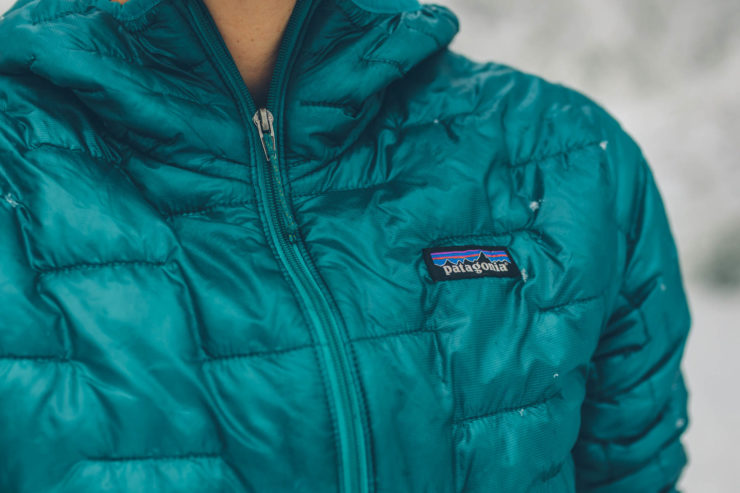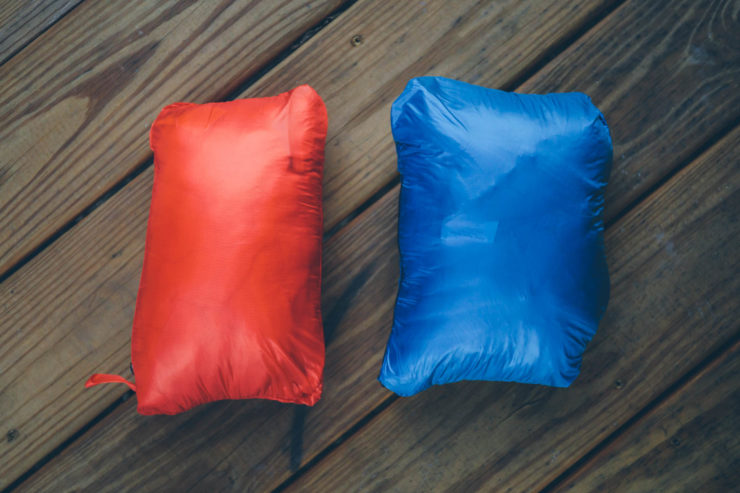Patagonia Micro Puff Hoody Review: Creatureless Comfort
As a cold-natured gal, and an ardent animal lover, Virginia was psyched to try out Patagonia’s latest synthetic down jacket, which is touted to have a better warmth to weight ratio than their ultralight down jackets, and be just as compressible. Read the detailed review after she wore it around town and on the trails for the last several months…
Finding the perfect ultralight puffy jacket has always involved some sort of compromise. Natural goose down generally provides the highest warmth to weight ratio of any insulator. It’s incredible loftiness traps the heat that our bodies generate. Down also compresses amazingly well, which is a critical factor when pack space is at a premium. Unfortunately, down has a few drawbacks. It does not repel water, and, when wet, it tends to clump up and lose its ability to loft. No loft= significantly reduced heat retention. Down also dries slowly, so once it’s gotten wet, it takes a long time to recover. Another major “down” fall is its source. Down comes from goose or duck plumage. While there are “responsible” means of harvesting down (see the Responsible Down Standard or Patagonia’s own stringent Traceable Down Standard), lots of folks just don’t feel comfortable wearing a by-product of somebody else’s death.
Synthetic insulation tolerates getting damp much better than down. The hydrophobic polyester fibers maintain their loft and insulating properties, and then also dry more quickly once saturated. Synthetic jackets are also a bit more breathable than down jackets, which adds to their versatility. Often they can provide comfort in a wide range of temperatures, even during active, sweat producing pursuits. But, when it comes to facing truly cold temperatures, jackets with synthetic insulation usually don’t provide as much warmth as down. And, as for packability, they don’t compress as well either.

Enter the Patagonia Micro Puff Hoody. The engineers at Patagonia worked long and hard to create a new kind of synthetic insulation, one they say addresses both the heat and compressibility shortfalls found in many polyester fills. The inspiration for its design… what else… goose down. The insulation, called PlumaFill, looks like a tiny feather boa, and features tufts of heat-trapping ultrafine polyester filament anchored to a single, central strand. Those fluffy offshoots compress like down, but stay warm and lofted when wet. The central strand design was employed to keep the insulation from shifting and clumping. With less shifty insulation, the need for individual baffles was eliminated. Instead, the Micro Puff is quilted with offset blocks of differing sizes. Theoretically, having fewer seams maximizes the efficiency of the insulation, allowing heat to move more freely throughout the jacket, creating a consistent distribution of warmth and preventing the formation of cold spots. So, that’s the science behind the Patagonia Micro Puff Hoody, but does it really deliver on all of its lofty promises?

Performance/Warmth
The Micro Puff jacket packs a lot of warmth into a small package. To be clear, it’s not a parka, but, with a medium weight wool base layer, the jacket has kept me quite comfortable in mid-30 (-1°C) to low-40s (4.4°C) temperatures (°F) while being relatively inactive. Once the temperature drops into the lower 30s, a heavier base layer can be added to lower this temperature rating. What’s really remarkable about this jacket is that it’s also a great piece of gear in temperatures ranging from the mid 60s (15.5°C) to lower 70s (21°C). I guess there aren’t many folks who think about wearing a jacket in 70 degree weather, but, as previously mentioned, I am cold-natured. Often the day starts off really cold and I just forget to take off my jacket until the afternoon, when temperatures start to climb.

Breathability
Despite some reviews I’ve read to the contrary, I think the Micro Puff Hoody is relatively breathable when compared to similar down fill jackets. I’ve worn the Micro Puff in low-mid 40°F (4.4°C) weather on some pretty grueling climbs. At times, I need to partially unzip it, but my perspiration evaporates quickly. But make no mistake, it is not a jacket purpose-built to breathe well during active pursuits, such as Patagonia’s Nano Air, another synthetic jacket that we reviewed in our roundup a couple years back. As Indiana Schulz — the second place finisher in the American Trail Race — answered when asked about his favorite pieces of gear on the trip, “The Patagonia Nano Air breathes amazingly well. You can wear it while riding and it actually works.” As such, the Nano Air had a slightly different shell fabric, and is pretty heavy (12.7oz/357g) and not very packable as a result. It’s also not as warm, which is where the Micro Puff Hoody shines.
Weather Resistance
In full disclosure, I haven’t submerged my jacket in a pool of water or worn it in a monsoon. Nevertheless, in my day-to-day activities (while living in the rainforest that I call home) I’ve been very impressed with the jacket’s water shedding capabilities. The ultralight nylon ripstop Pertex Quantum shell has a DWR (durable water repellent) finish that allows light precipitation to just roll off the surface. Heavier rain seems to impregnate the shell (at least it looks saturated) without affecting the insulation’s loft or soaking through to the inner lining.
As a natural born skeptic, I imagine that the DWR finish will begin to wear in time. If that is the case, or my plans are likely to get me stuck in a sustained downpour, I’ll most likely throw on a light shell for added protection… something like my Outdoor Research Helium II, which fits quite comfortably as a top layer.
The Micro Puff’s shell also provides decent windproofing. While there are some weaknesses when compared to a garment with no thru-seams, the unique construction of this jacket means those gaps are minimized.
Fit
The Patagonia Micro Puff Hoody feels decidedly slimmer than other lightweight jackets I’ve tried, and I mean that in a good way. I am not a fan of Michelin-man type bulk, and I don’t want anything interfering with my range of motion, or the ability to add base layers. This jacket is pretty much perfect in that regard. I generally wear a size medium in any article of clothing, so that’s what I opted for with this jacket. It fits well, not exactly “form fitting”, but that’s not my style anyway. I have room to wear a heavy weight baselayer underneath it and still feel flexible. The no frills elastic binding on the cuffs, hood, and bottom trim provide enough cinch to keep things in place without being at all constricting.
Features
The Micro Puff jacket isn’t flush with fancy features, but, unlike some ultralight gear, its not bare bones either. It has two zippered handwarmer pockets and two deep interior, elasticized drop-in pockets. One of the handwarmer pockets doubles as a stuff sack with an integrated cord loop, so it can be clipped to a pack or harness. In comparison to other jackets I’ve worn, the pocket stuff sack accommodates the jacket far more easily. That saves time and frustration when packing, but it means that there’s a little wasted space in the end. If space preservation is a high priority, an added compression strap or smaller stuff sack may be in order.
The hood, while simple in construction, fits well. It lacks any means for adjustment, so individuals with smaller heads might find that the hood rides a little low on the forehead, but the profile is eased sufficiently to not interfere with peripheral vision…a major plus. Also, as advertised, the hood does fit under my bike helmet.
The women’s Micro Puff comes in four colors… black, Elwha Blue, Feather Grey, and magenta. The men’s is available in black, Forge Grey, Paintbrush Red (which is more orange as you can see in some of these photos), and Viking Blue.
Weight/ Pack Size
Here’s where the Micro Puff really shines. The size medium women’s version weighs in at a scant 243 grams (8.6oz), which is slightly above the 8oz claimed. No other synthetic jacket that I’ve researched can match that. It’s also highly compressible. As previously mentioned, it packs neatly into the integrated stuff sack/hand warmer pocket with room to spare. Fully compressed, it’s about the size of a standard 24oz water bottle. For bikepacking in cool weather, this jacket’s weight and compressibility make it a dream. My previous down jacket provided a comparable degree of warmth but occupied a significantly larger footprint.
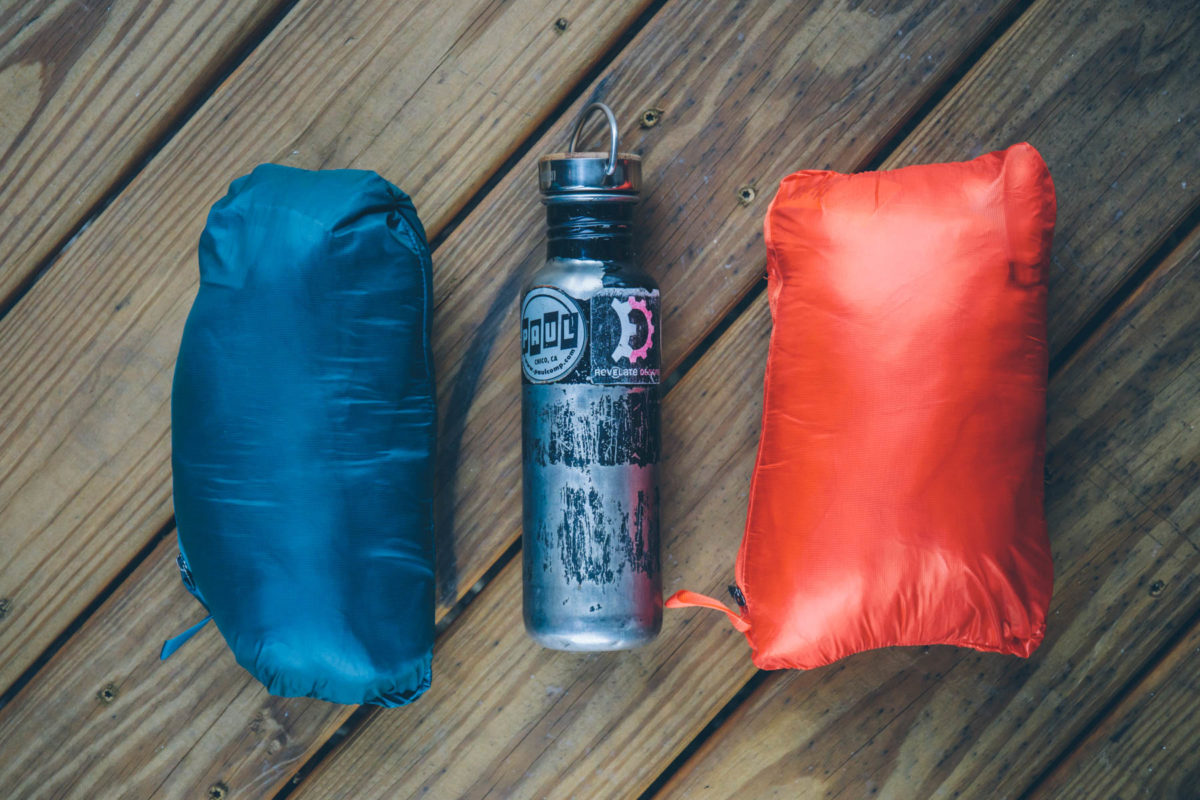
Top and left images shows men’s medium (orange) and women’s medium (blue); lower right image shows men’s Micro Puff Hoody next to the Patagonia Ultralight Down Jacket (see below boxout for comparison).
Patagonia Micro puff Hoody vs Ultralight Down
When put head to head against Patagonia’s proven Ultralight Down Jacket, there are a couple things to note. First, as Virginia mentioned, she found the Micro Puff to be slightly delicate (although I second the fact that she is rough on gear). That said, the Patagonia Ultralight Down Jacket has a slightly thicker skin. It features a 15-denier ripstop Pertex Quantum shell while the Micro Puff Hoody has a 10-denier Pertex Quantum shell. As far as weight, my non-hooded medium UDJ tips the scales at 257g compared to a medium men’s hooded MPH at 270g. Tack on a hood and the MPH is definitely lighter, and in my opinion similar on the warmth meter. – Logan
Durability
With all of its strengths, the Micro Puff Hoody has one substantial drawback. The same element that allows for its incredibly low weight and weather resistance comes at a price. The jacket’s Pertex Quantum® shell is made with delicate 10 denier ripstop nylon. Admittedly, I tend to be a little rough on things, but it’s not like I’ve been wading through thorny bushes or scaling granite in this jacket. Nevertheless, I’ve sustained a few tiny pinholes in a relatively short period of time. Fortunately, they seem to be self-limiting, and, because of its linear design, the insulation is staying in place save a few tufts here and there that need to be trimmed.
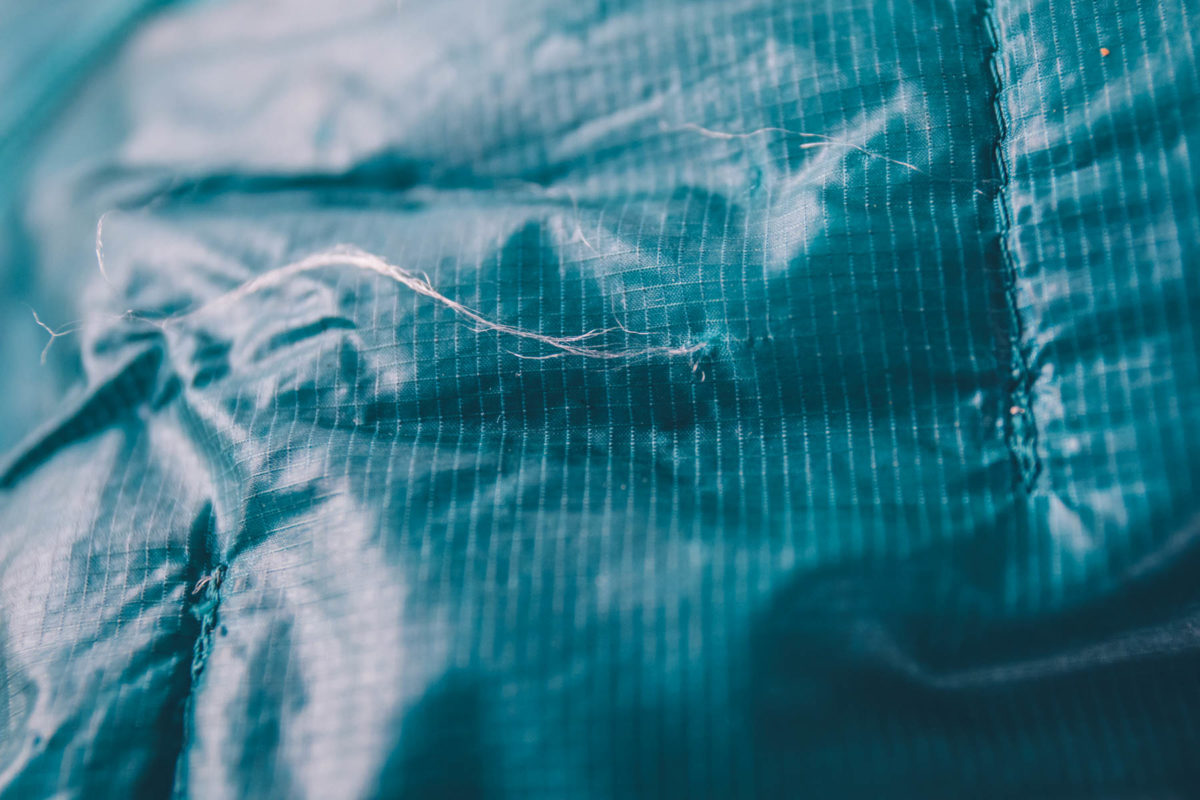
All of that being said, this jacket probably isn’t the best choice for rock scramblers or those who want to bundle up while riding through dense brush. But, for those folks who know how to care for their gear and don’t often stray too far into bushwhacking territory during the colder months, the delicacy of the shell shouldn’t be a deal breaker.
Pros
- Lightweight: The women’s size medium weighs in at a mere 243g (8.6oz)
- Warmth: This jacket holds in a lot of heat in a small package.
- Packability: It compresses down to the size of a 24oz water bottle, most synthetic jackets don’t come close.
Cons
- Delicate: Most ultralight gear is somewhat delicate, but this shell seems particularly sensitive to abrasions.
- Price: At $299, the Micro Puff Hoody isn’t cheap. There may be comparably warm jackets at lower price points, but my bet is that they won’t be nearly as light or compressible.
- Model Tested Women’s/Men’s Micro Puff Hoody (medium)
- Insulation 65g of PlumaFill synthetic
- Weight Women’s: 243g (8.6oz) / Men’s 270g (9.5oz)
- Place of Manufacture Vietnam
- Price $299
- Manufacturer’s Details Link
Wrap Up
Patagonia claims the Micro Puff Hoody is the best warmth to weight ratio jacket they’ve ever constructed. While some may argue the proprietary Pluma Fill insulation may not hold on to heat quite as well as down, it’s very very close. And unlike its animal derived competition, the synthetic material stays lofted and warm when wet. The superlight nylon ripstop shell blocks wind and its DWR coating does an impressive job at shedding moderate precipitation. To top it off, the Micro Puff compresses as well as any down jacket I’ve used, weighs next to nothing, and does it all without harming a soul. Its delicate shell is definitely something that needs to be taken into consideration by would-be wearers, but considering most bikepackers limit their puff for hanging out at camp, adding a sleeping layer, or cold rides out of camp in the morning, I think this jacket is a great fit for most bikepacking expeditions.
Please keep the conversation civil, constructive, and inclusive, or your comment will be removed.






